What do you wear to your traditional wedding, marriage introduction of traditional engagement? In this post, you’ll find over 100 ideas of the latest Yoruba Traditional Wedding Attire for brides and grooms, including couples matching styles.
You’ll find fabric ideas for Yoruba weddings including aso-oke and lace. You’ll also find style ideas from Iro and Buba attire for Yoruba brides, Agbada attire for Yoruba grooms. You’ll also find the best colour combo inspirations for Yoruba Traditional Engagement.
Now, swipe or scroll down to see our editorial picks for the latest Yoruba Traditional Wedding Attire for brides and grooms.
1. Cotton-Weave Aso-oke and Iridescent Aso-oke Styles for Yoruba Traditional Wedding
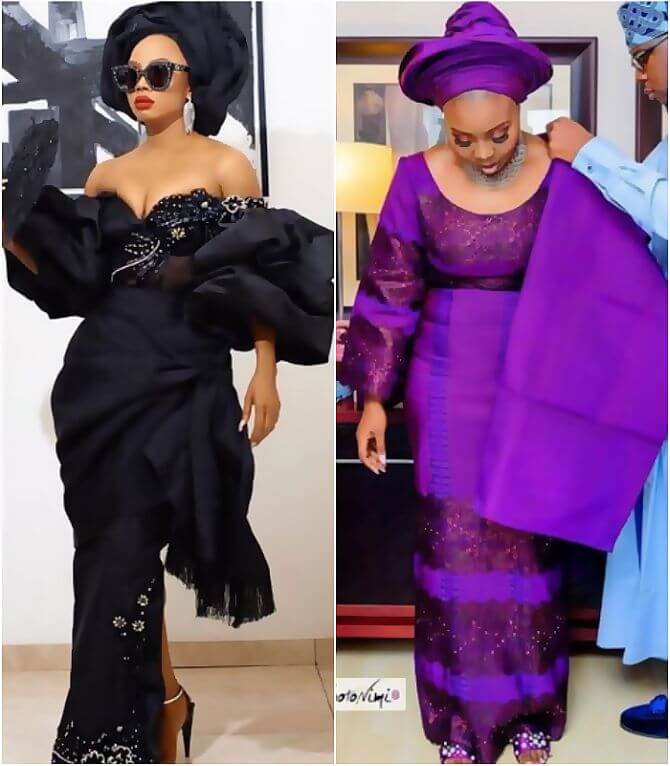
- Above Left: Black sweetheart neck cotton-weave aso-oke Iro Gown with flower silver applique details and dramatic statement sleeves.
- Right: Bride in a purple iridescent Iro and Buba aso-oke with matching Gele and Ipele.
2. Stoned Aso-Oke Outfits & Designs for Yoruba Brides and Couples
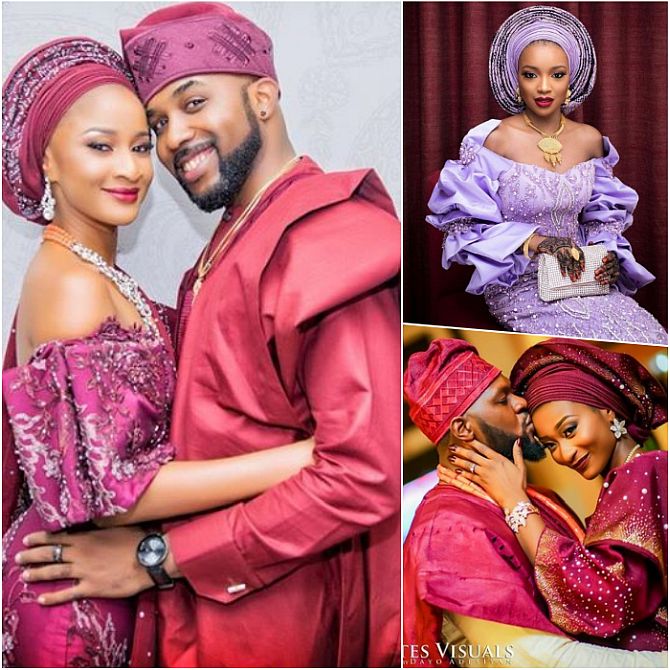
- LEFT: The Wellingtons in their traditional wedding attire – burgundy aso-oke long gown with gele for bride and crimson red coloured agbada for the groom.
- ABOVE RIGHT: Bride in a lilac stoned aso-oke with gele headtie.
- BOTTOM RIGHT: Bride in a burgundy aso-oke with a touch of white. Her groom is wearing a matching burgindy agbada and fila/ cap.
3. Classic Striped Aso-oke Yoruba Traditional Wedding Attire
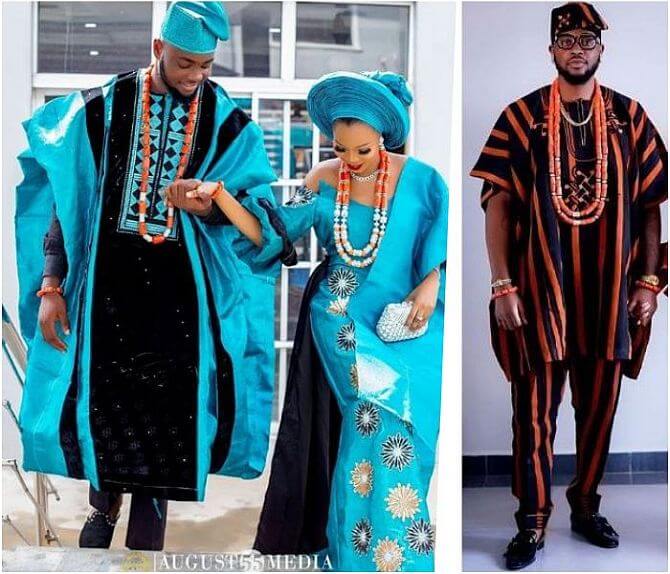
- Above Left: Couple in matching sky blue and black aso-oke – groom in a blue-black men’s agbada and bride in sky-blue appliqued aso-oke long gown and gele.
- Above Right: Ex-BBNaija star, TeddyA, wearing a striped orange and black aso-oke in dashiki style for his Yoruba traditional wedding ceremony to fellow Big Brother Naija housemate, BamBam.
4. Embellished, Sequined and Beaded Aso-oke Attires for Traditional Marriage
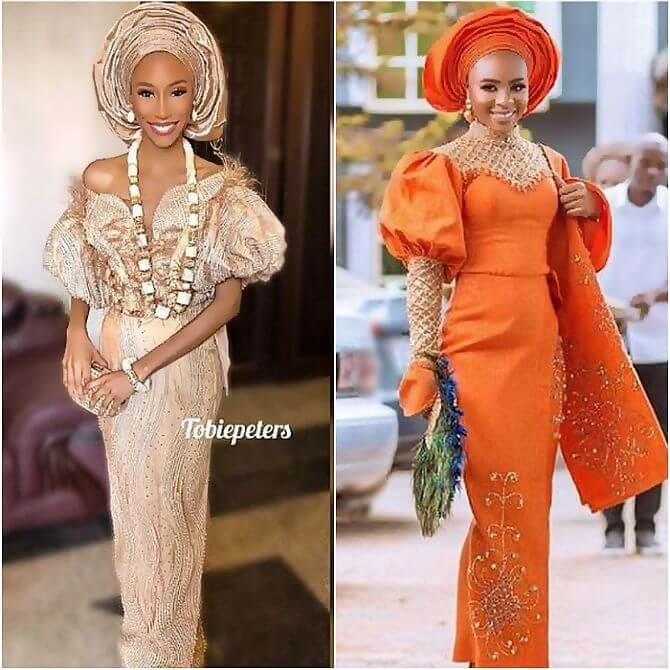
- LEFT: Rose-gold sweetheart neck beaded aso-oke long gown with puff hand.
- RIGHT: Orange high-neck puff sleeve embellished aso-oke maxi gown with Bishop sleeves.
5. Silk Aso-oke Yoruba Traditional Wedding Attire
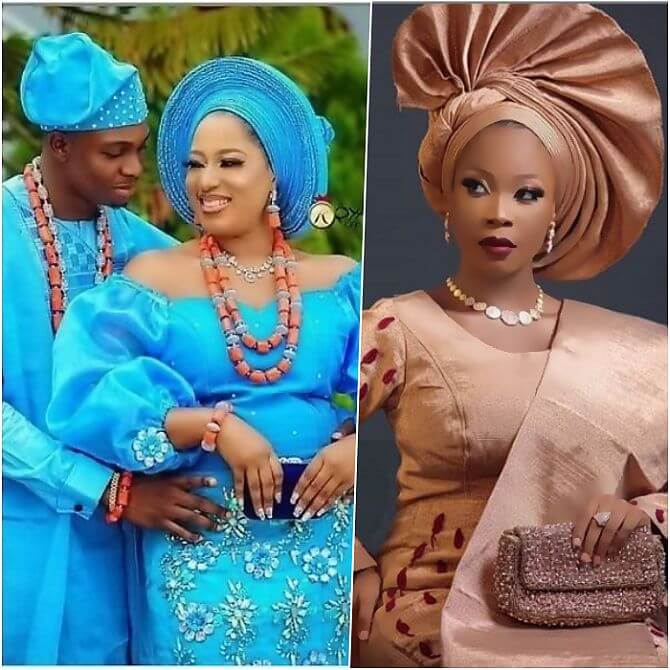
- Above Left: Couple in matching light blue aso-oke attire for their Yoruba traditional wedding. |
- Right: Bride in a rose-gold laser-cut aso-oke iro gown style.
100 Aso-Oke Yoruba Traditional Wedding Attire for Couples (Video)
Play the video below for photos of 100+ beautiful aso-oke traditional attire styles for Yoruba couples – including styles of women, styles for men, and matching couple Aso-oke colours and designs.
10 Fancy Gown-Wrapper and Iro-Gown Styles Every Woman Should Have
Types and Designs of Aso-Oke Fabrics
There are many different types of aso-oke fabrics in the market. However, back in the days, there were only 3 types, differentiated only by colours.
At that early time, there were just three main aso-oke colours, traditionally – etu aso-oke (dark blue with stripes), alaari baba aso-oke, and Sanyan/ Soyon aso-oke (brown, with stripes pattern). These are still available, as the classic, traditional aso-oke designs.
Modern aso-oke fabrics and designs are more colourful, bling-bling and light-weight than the early, classic aso-oke fabric designs. Today, the aso-oke cloth weavers are sourcing assorted types of thread looms and colours, so aso-oke types have increased.
The new types of aso-oke are categorized based on their weave designs, pattern and thread types, and they include:
- Cotton-weave aso-oke design
- Double weave aso-oke design
- Damask aso-oke
- Lace aso-oke (net lace, ordinary lace)
- Iridescent Aso-oke
- Embellished, Sequined and Beaded Aso-oke
- Laser Cut Aso-oke and Handcut aso-oke design (looks and feels like lace fabric)
- Kente aso-oke (Kente-oke)
- Metallic aso-oke
- Net aso-oke design
- Normal net design
- Super-net aso-oke
- Silk aso-oke
- Cotton aso-oke
- Wire aso-oke
- Aso-oke with Print art work design
- Aso-oke with Monogramming
- And many others.
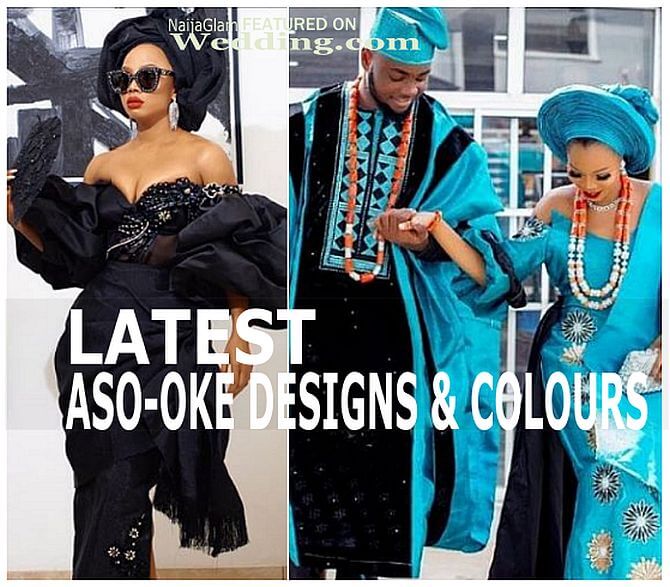
Aso-Oke for Yoruba Traditional Wedding
Aso-oke woven fabric is produced and sold in pieces of cloth, so that the buyer would sew them to fit his/ her own size. The aso-oke styles are classic – the men make their aso-oke in a similar style, and similar style, and the women’s aso-oke styles are sewn in the same fashion.
BRIDES ASO-OKE TRADITIONAL WEDDING ATTIRE: The complete Aso-Oke look for Yoruba brides at traditional wedding include an Iro (wrapper) and Buba (blouse), a matching Gele (Headtie) and Ipele or Iborun (shawl), a beaded necklace and a hand fan.
GROOMS ASO-OKE YORUBA TRADITIONAL WEDDING ATTIRE: The men’s w aso-oke style is traditionally a three-piece attire, consisting of a trouser (sokoto), a tunic-style top (buba or dansiki), a flowing robe (agbada – this is worn over the buba) and a cap/ hat (fila).
Because of the importance attached to the aso-oke fabric, and the prestige that the fabric bestows to the wearer, aso-oke is the preferred clothing for brides and grooms. It’s also a premium fabric for the parents of the celebrants, during their traditional engagement ceremonies and wedding.
Colourful, uniformed aso-oke attires are also worn as “aso-ebi’ by friends and family of a celebrant, or bride or groom – makes the event look colourful and the wearers stand out.
How to Tie Nigerian Wrapper: Igbo Double Wrapper, Yoruba Style & Knot Style (Video Tutorial)
Origin and History of Aso-Oke Fabric
Aso oke (pronounced: AH-SHOR-OKAY) is a patterned cloth, hand-woven by the Yoruba people of South-West Nigeria. Literally, the word ‘aso-oke’ means ‘top cloth’ or ‘high cloth’ or “clothing for prestige’/ ‘prestigious cloth’(translated to English).
Aso-oke is the ceremonial clothing worn on special occasions during special such as chieftaincy ceremonies, parties, weddings, christening/ naming ceremony, traditional festivals, and other important occasions. Aso-oke is also the cloth for royalty, worn by the Obas (Kings).
One of our Yoruba readers, Tolulope, was kind enough to let us know that the Yoruba word “Aso oke” was derived from the early name of this fabric, “aso ilu oke”, which when translated, meant clothing from the highland.
The Yoruba word “oke” in the word ‘Aso-Oke’ refers to highland (topography) and not social status. That’s because the fabric was sourced from the highland part of Yorubaland (precisely, the source was Iseyin in Oyo state of Nigeria).
FUN FACT: Just so you know, the parts of Yorubaland referred to as lowlands (areas with low topography) include Lagos, Ijebu, Badagry, to name but a few. Today, the meaning of “aso-oke” has become modified to also mean ‘top-class or premium cloth’ or ‘clothing for prestige’.
Incidentally, the Yoruba word “oke” also means TOP. Aside from being a clothing attire, Aso-oke was worn as a symbol, or to showcase prestige and wealth. So, if you saw someone wearing aso-oke, you immediately knew they were a royal or very important personality.
How Aso-Oke Cloth Weaving Industry Began
Here’s how cloth weaving started with the Yoruba people. Back in the days, the Yoruba people had very big cotton farms.
Also, processing of cotton to cloth was a source of livelihood for most cotton-farming families who were self-contained mini-textile industries.
At the time, almost every family member was involved in the production line. The women and children spun the harvested cotton into threads, and also dyed the threads into various colours.
Some men and women were skilled in the craft of weaving the threads into Aso-Oke cloth.
The aso-oke industry and demand have since grown so big that it’s no longer dependent on cotton produced within small families.
Today, the production of aso-oke has significantly changed – big cotton farms have disappeared, along with local cotton spinners and thread dyers.
These days, Aso-Oke Weavers now source for imported, ready-made threads that they use to weave their aso-oke.
Also, they are no longer confined to weaving aso-oke cloth with cotton. They now use other types of threads including silk, rayon and shiny metallic lurex (from Japan).
Back in the days, the traditional weavers made aso-oke in three main colours – blue (called ‘etu’), crimson red (called ‘alaari’), and brown (‘sanyan’). At that time, the aso-oke designs were mainly stripes – blue stripes or red stripes or brown stripes.
Over years, everything about the aso-oke fabric – designs, patterns and colours – has evolved into creating some of the most elegant and prestigious textile in the World.
While such changes added to the cost of finished modern aso-oke, it also increased its appeal to the international market. Today, Aso-oke is now worn beyond the borders of Yoruba states (in and outside Nigeria).
These developments in did not wipe out the demand and weaving of aso-oke in it’s old, original striped designs and colours.
They’re still beautiful and not out of trend. You can still find the classic, traditional aso-oke sold in Nigeria.
Production of Aso-oke
Have you ever wondered ‘how is aso-oke fabric is produced’? ‘Aso oke’ cloth is woven on a narrow loom. The end product is a 40-foot strip of cloth.
Traditionally, aso-oke is sold in strips of narrow cloth – just the way they are produced. The buyer would then find a tailor to join the pieces together, in order to make a full cloth.
Today, you can still find aso-oke cloth packaged in the classic, traditional way or you can buy strips of the woven cloth from one of many retailers who sell already-joined, complete aso-oke cloth.
Wrapping Up
There you have it on the latest aso-oke traditional wedding and engagement attires for Yoruba couples. You may want to see our tips and ideas on best colours to combine for dressing with aso-oke or other materials.
Now, I’d like to hear your thoughts on this post. Also, let me know which of the featured aso-oke outfit is your favourite.
Hello, please I need your advice, I picked white and purple as general colour, I don’t know what colour my husband and I will use.
Thanks
Hi Abimbola, I guess you’re choosing for your traditional wedding (since you didn’t specify).
Here are some ideas:
Purple and Silver
Purple and Gold
Purple and light yellow
royal purple and champagne gold
Purple and peach
Purple and baby pink
Purple and lavender
Purple and Ash
Purple and Gray
Purple and Charcoal
If you like Onion Purple, you may want to see our Onion Purple colour combos post for more ideas.
Hope that helps.
I don’t know which colour to pick for my traditional wedding
An idea is to pick your best colour. Everyone has their favourite colours, and so do you. That’s a starting point. Your wedding day should be about showcasing your personality, including your favourite colour.
Hi,
I pick mint green and champagne gold for my traditional wedding but am not sure of wat color to pick for the family
Hello Bukky, that’s a pretty traditional wedding colour combo you chose. Take a look at our peach colour combinations list for traditional wedding – you are likely to find something from the over 50 colour combos I listed there.
Beautiful piece. Well-done. Permit me to correct, however that Aso oke derives Aso ilu oke, that is, clothing from the highland, ( the oke refers to highland not social status), because it was sourced from that part of yorubaland, to be precise Iseyin in Oyo state. The lowlands of yorubaland , that is those with low topography include Lagos, ijebu, badagry etc.
Thank you
Thanks, Tolulope – for reading, commenting and shedding more light on the history of the aso-oke. I loved your comment so much that I have now edited the post to include it (with credit to you, of course).
I love what I saw
Thanks
Thank you dearie.
aso oke is cute for
wedding
You’re right, Justice. Aso-oke make an elegant fashion statement when worn by couples during weddings.
aso ebi its uncommon dress it make us lukn good
Very correct, Omolara. Aso-ebi makes weddings uniquely colourful.
Aso-oke. is one of the best and most beautiful fashion
You’re right. Aso-oke are really fashionable as occasion wear.
If I want my designs (bridal hair pieces, hatinators & fascinators, hand fans) featured in your magazine, how do I go about it? Thanks.
Hi Adetoro. Welcome to NaijaGlamWedding. To have your business featured on our site, you can purchase any of our very affordable advert types. Click here to find out about them and reach more Naija brides (home and abroad) who read NaijaGlamWedding.
Hi Hadetoro. Welcome to NaijaGlamWedding. To have your business featured on our site, you can purchase any of our very affordable advert types. Click here to find out about them and reach more Naija brides (home and abroad) who read NaijaGlamWedding.
I want know more type of aso oke colours and designs
Hi Olanrewaju, we plan to release a special article on colour combinations for aso-oke and Nigerian traditional attire for weddings. If you signup to receive our site updates by email or keep checking from time to time, you will know when we finally write the article. Thanks.
Plz waiting for reply
Check your email – was sent early morning.
Plz I need some of the design Aso-oke for my traditional wedding. Thanks
Hi Nana:
Contact the aso-oke makers/ sellers we mentioned above (scroll up, the links are up there, under where we wrote: “Where To Buy Nigerian Aso-Oke Fabrics?).
Contact them directly through their websites and facebook pages. You can start with the Facebook pages of Needles and Thread Aso-oke on Facebook and Bellisimo aso-oke. Happy shopping. (Note: We are a magazine wedding website and son’t sell aso-oke. We only feature the best designs for our readers, and also mention some places we know that sell top designs).